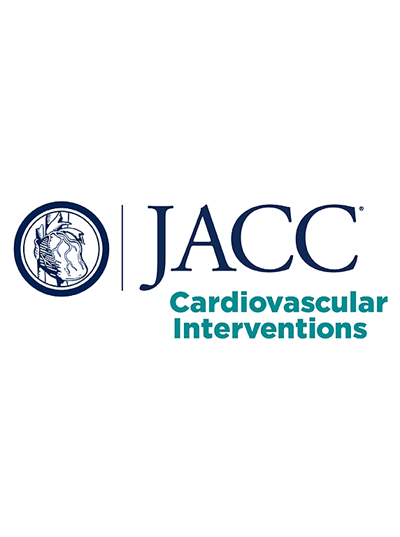Eos系统经股导管二尖瓣置换术1年疗效观察
IF 11.4
1区 医学
Q1 CARDIAC & CARDIOVASCULAR SYSTEMS
引用次数: 0
摘要
背景:经导管二尖瓣置换术(TMVR)可能有利于手术风险高的二尖瓣返流(MR)患者。目的报告经股TMVR术后30天和1年的预后。MISCEND (Edwards Eos二尖瓣置换术:经导管装置二尖瓣置换术后安全性和性能的研究)研究是一项前瞻性、单臂、多中心评估Eos经导管二尖瓣置换术系统的临床意义、症状性MR性能和安全性终点,包括器械成功率、手术成功率、30天MR≤1+率和30天综合主要不良事件发生率。随访1年,评估其他临床、超声心动图、功能和生活质量结果。结果纳入60例患者(中位年龄79.5岁,胸外科学会评分5.2%,男性占40%,功能性MR占43.3%)。器械和手术成功率均为100.0%。30天的综合主要不良事件发生率为43.3%,包括全因死亡(5.0%)、全因住院(21.7%)、非选择性二尖瓣再介入(1.7%)、严重出血(28.3%)、需要计划外透析或肾脏替代治疗的肾脏并发症(5.0%)和主要心脏结构并发症(8.3%)。30天MR≤1+的比例为98.1%,1年MR≤1+的比例为100.0%,63.0%和78.4%的患者无MR /微量MR。一年的结果显示,6分钟步行距离(40.5 m; 95% CI: 13.8-97.2 m; P = 0.003)和堪萨斯城心肌病问卷总分(17.7分;95% CI: 11.2-27.3分;P < 0.01)显著改善,86.8%的患者处于NYHA功能I/II级。死亡率和左室假性动脉瘤分别为20.3%和10.0%。结论1年的MISCEND结果证明了Eos系统TMVR的可行性。尽管与左室假性动脉瘤相关的安全性问题导致了研究登记的停止,但研究结果将为未来的治疗发展提供信息。本文章由计算机程序翻译,如有差异,请以英文原文为准。
1-Year Outcomes of Transfemoral Transcatheter Mitral Valve Replacement With the Eos System
Background
Transcatheter mitral valve replacement (TMVR) may benefit patients at high surgical risk with mitral regurgitation (MR).
Objectives
The authors report 30-day and 1-year outcomes of transfemoral TMVR.
Methods
The MISCEND (Edwards Eos Mitral Valve Replacement: Investigation of Safety and Performance After Mitral Valve Replacement With Transcatheter Device) study is a prospective, single-arm, multicenter evaluation of the Eos transcatheter mitral valve replacement system for clinically significant, symptomatic MR. Performance and safety endpoints included device success, procedural success, 30-day rate of MR ≤1+ and 30-day composite major adverse event rate. Additional clinical, echocardiographic, functional, and quality-of-life outcomes were assessed through 1 year.
Results
Sixty patients (median age 79.5 years, Society of Thoracic Surgeons score 5.2%, 40% men, 43.3% with functional MR) were enrolled. Device and procedural success rates were 100.0%. The 30-day composite major adverse event rate was 43.3%, including all-cause mortality (5.0%), all-cause hospitalization (21.7%), nonelective mitral valve reintervention (1.7%), severe bleeding (28.3%), renal complication requiring unplanned dialysis or renal replacement therapy (5.0%), and major cardiac structural complication (8.3%). The rate of MR ≤1+ was 98.1% at 30 days and 100.0% at 1 year, with none/trace MR in 63.0% and 78.4% of patients, respectively. One-year outcomes showed significant improvements in 6-minute walk distance (40.5 m; 95% CI: 13.8-97.2 m; P = 0.003) and Kansas City Cardiomyopathy Questionnaire overall score (17.7 points; 95% CI: 11.2-27.3 points; P < 0.01), with 86.8% of patients in NYHA functional class I/II. Rates of mortality and left ventricular pseudoaneurysm were 20.3% and 10.0%, respectively.
Conclusions
1-year MISCEND results demonstrate the feasibility of TMVR with the Eos system. Although safety concerns related to left ventricular pseudoaneurysm resulted in the cessation of study enrollment, learnings will inform future therapy development.
求助全文
通过发布文献求助,成功后即可免费获取论文全文。
去求助
来源期刊

JACC. Cardiovascular interventions
CARDIAC & CARDIOVASCULAR SYSTEMS-
CiteScore
11.60
自引率
8.80%
发文量
756
审稿时长
4-8 weeks
期刊介绍:
JACC: Cardiovascular Interventions is a specialist journal launched by the Journal of the American College of Cardiology (JACC). It covers the entire field of interventional cardiovascular medicine, including cardiac, peripheral, and cerebrovascular interventions. The journal publishes studies that will impact the practice of interventional cardiovascular medicine, including clinical trials, experimental studies, and in-depth discussions by respected experts. To enhance visual understanding, the journal is published both in print and electronically, utilizing the latest technologies.
 求助内容:
求助内容: 应助结果提醒方式:
应助结果提醒方式:


